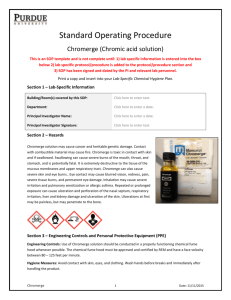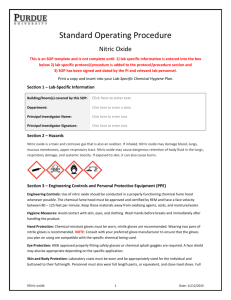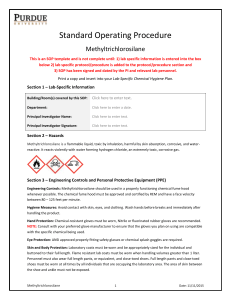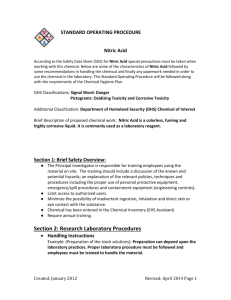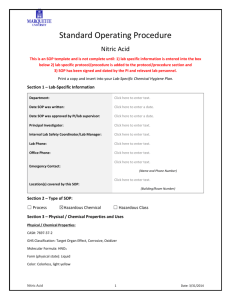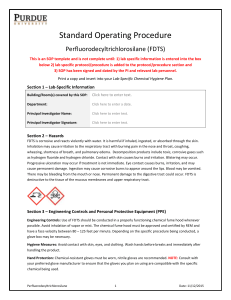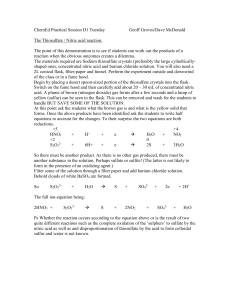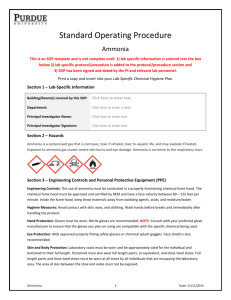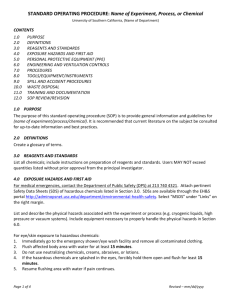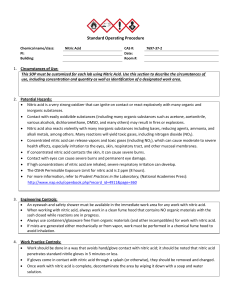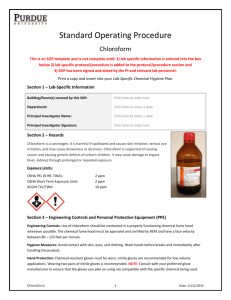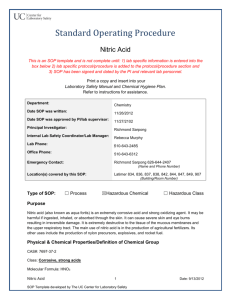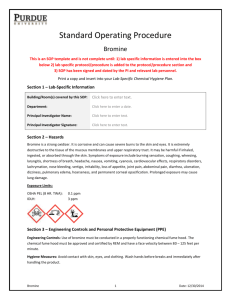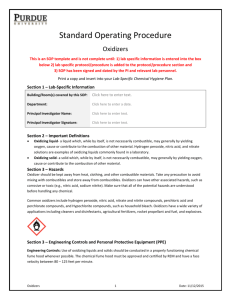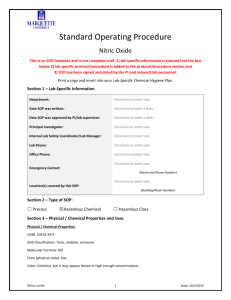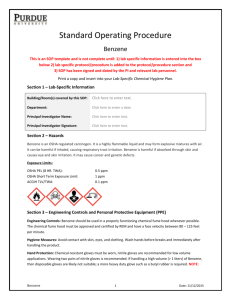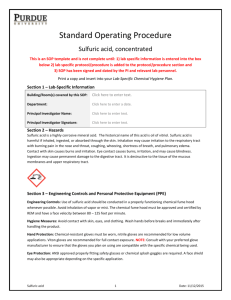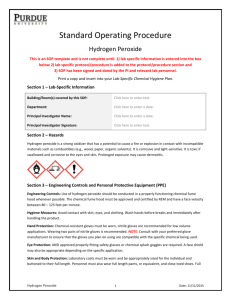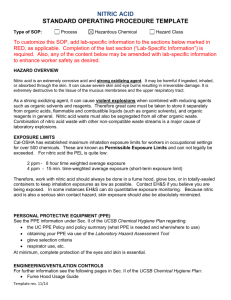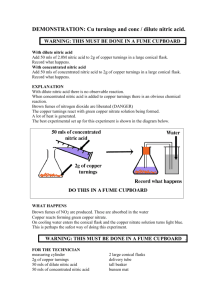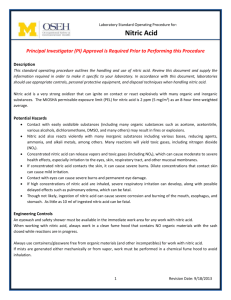Nitric Acid
advertisement
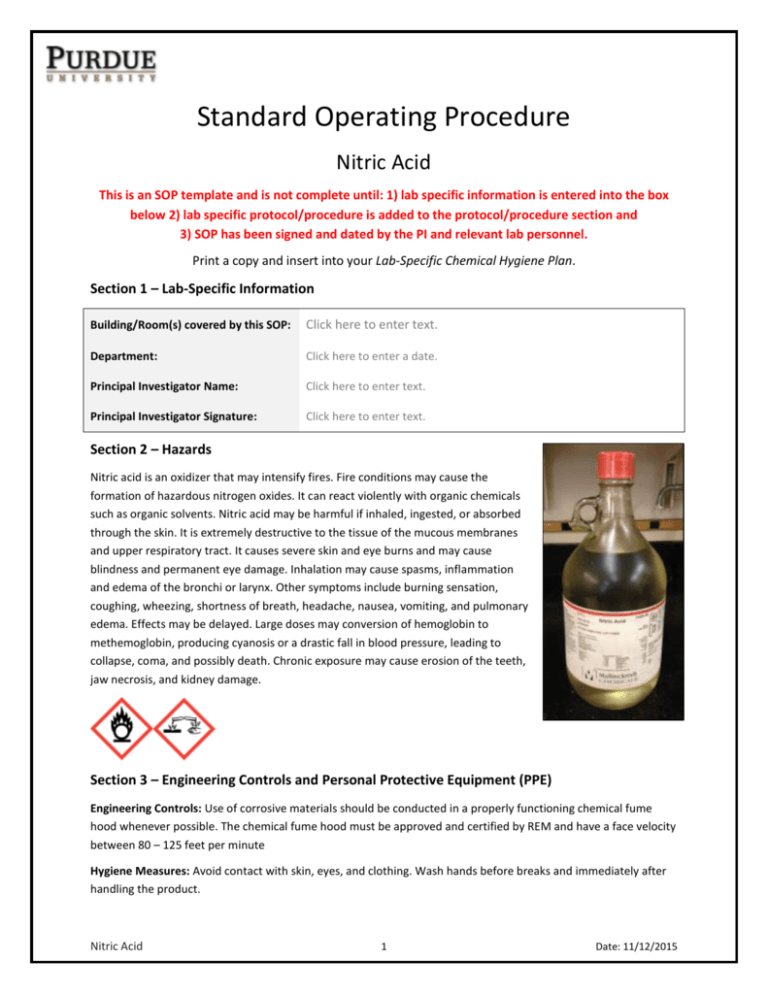
Standard Operating Procedure Nitric Acid This is an SOP template and is not complete until: 1) lab specific information is entered into the box below 2) lab specific protocol/procedure is added to the protocol/procedure section and 3) SOP has been signed and dated by the PI and relevant lab personnel. Print a copy and insert into your Lab-Specific Chemical Hygiene Plan. Section 1 – Lab-Specific Information Building/Room(s) covered by this SOP: Click here to enter text. Department: Click here to enter a date. Principal Investigator Name: Click here to enter text. Principal Investigator Signature: Click here to enter text. Section 2 – Hazards Nitric acid is an oxidizer that may intensify fires. Fire conditions may cause the formation of hazardous nitrogen oxides. It can react violently with organic chemicals such as organic solvents. Nitric acid may be harmful if inhaled, ingested, or absorbed through the skin. It is extremely destructive to the tissue of the mucous membranes and upper respiratory tract. It causes severe skin and eye burns and may cause blindness and permanent eye damage. Inhalation may cause spasms, inflammation and edema of the bronchi or larynx. Other symptoms include burning sensation, coughing, wheezing, shortness of breath, headache, nausea, vomiting, and pulmonary edema. Effects may be delayed. Large doses may conversion of hemoglobin to methemoglobin, producing cyanosis or a drastic fall in blood pressure, leading to collapse, coma, and possibly death. Chronic exposure may cause erosion of the teeth, jaw necrosis, and kidney damage. Section 3 – Engineering Controls and Personal Protective Equipment (PPE) Engineering Controls: Use of corrosive materials should be conducted in a properly functioning chemical fume hood whenever possible. The chemical fume hood must be approved and certified by REM and have a face velocity between 80 – 125 feet per minute Hygiene Measures: Avoid contact with skin, eyes, and clothing. Wash hands before breaks and immediately after handling the product. Nitric Acid 1 Date: 11/12/2015 Hand Protection: Two-sets of chemical-resistant gloves (e.g., nitrile) should be worn (“doublegloving”). A heavy-duty glove, such as butyl rubber, Viton, or equivalent, is recommended, especially when handling concentrated nitric acid or more than 1L. NOTE: Consult with your preferred glove manufacturer to ensure that the gloves you plan on using are compatible with the specific chemical being used. Eye Protection: ANSI approved properly fitting safety glasses or chemical splash goggles are required. A face shield is also recommended Skin and Body Protection: Laboratory coats must be worn and be appropriately sized for the individual and buttoned to their full length. Personnel must also wear full length pants, or equivalent, and closetoed shoes. Full length pants and close-toed shoes must be worn at all times by all individuals that are occupying the laboratory area. The area of skin between the shoe and ankle must not be exposed. Respiratory Protection: If nitric oxide is being used outside of a chemical fume hood, respiratory protection may be required. If this activity is necessary, contact REM (4-6371) so a respiratory protection analysis can be performed. Section 4 – Special Handling and Storage Requirements Avoid contact with skin, eyes, and clothing. Keep container tightly closed in a dry and well-ventilated area. If possible, store in corrosive/acid/lab storage cabinet within a secondary containment (Nalgene/ polypropylene tray or tub). Store in original container away from direct sunlight. Avoid contact with alkali metals, reducing agents, cyanides, aldehydes, powdered metals, ammonia, and acetic anhydride, and all organic materials including organic solvents. Do not store in the top most shelf of the storage cabinet. In general, do not store chemicals at or above eye level. Ensure the container is tightly closed at all times. Section 5 – Spill and Accident Procedures Immediately evacuate area and ensure others are aware of the spill. If there is an imminent threat of a fire, pull the nearest fire alarm station to evacuate the building and dial 911. If personnel have become exposed and need medical assistance, dial 911. If the spill is minor and does not pose a threat to personnel, contact REM at 49-40121 during normal business hours (Monday – Friday, 7 AM – 4 PM) for spill cleanup assistance (dial 911 if spill occurs after hours and assistance is needed). Section 6 – Waste Disposal Procedures Store hazardous waste in closed containers that are properly labeled, and in a designated area (flammable cabinet is recommended). Nitric acid waste should be segregated from all incompatible chemicals such as caustics. Complete a Chemical Waste Pickup Request Form to arrange for disposal by REM; detailed instructions are provided at the following link: http://www.purdue.edu/ehps/rem/hmm/chemwaste.htm. Section 7 – Protocol (Add lab specific Protocol/Procedure here) Click here to enter text. Nitric Acid 2 Date: 11/12/2015 NOTE: Any deviation from this SOP requires approval from PI. Section 8 – Documentation of Training (signature of all users is required) Prior to conducting any work with nitric acid, the Principal Investigator must ensure that all laboratory personnel receive training on the content of this SOP. I have read and understand the content of this SOP: Name Signature Date Click here to enter text. Click here to enter a date. Click here to enter text. Click here to enter a date. Click here to enter text. Click here to enter a date. Click here to enter text. Click here to enter a date. Click here to enter text. Click here to enter a date. Click here to enter text. Click here to enter a date. Click here to enter text. Click here to enter a date. Click here to enter text. Click here to enter a date. Click here to enter text. Click here to enter a date. Click here to enter text. Click here to enter a date. Click here to enter text. Click here to enter a date. Nitric Acid 3 Date: 11/12/2015
